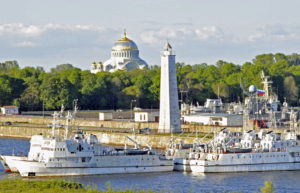
Kronstadt Naval Base near St. Petersburg, Russia (Photo by Don Knebel)
In 1703, Czar Peter the Great established St. Petersburg at the head of the Gulf of Finland. A year later, to guard against naval attacks, he established a fortress on Kotlin Island in the middle of the gulf about 19 miles west of his new city. The area around the fortress, known as Kronstadt, became the base of Russia’s Baltic Fleet. Today, Kronstadt remains one of the bases of that fleet.
In the nineteenth century, Russian naval officials began promoting the idea of an imposing cathedral on Kronstadt to honor those killed serving the Russian Navy. The idea was promoted by a popular local priest, later canonized as St. John of Kronstadt. In 1897, Czar Nicholas II approved the idea. Russian architects then traveled to Turkey and Greece to collect ideas about the designs of historic Byzantine cathedrals. A domed cathedral, modeled on Istanbul’s sixth century Hagia Sophia, was erected on Kronstadt’s Anchor Square, once the resting place of used anchors. The massive cathedral, honoring St. Nicholas, not coincidentally also the name of the czar, was consecrated in 1913, the 300th anniversary of the founding of the Romanov dynasty. Five years later, the Communist government executed Czar Nicholas and then closed the cathedral, confiscating its treasures. The cathedral was subsequently repurposed as a cinema, a community center for Kronstadt officers and a museum, destroying much of its ornate interior.
In 2002, the Russian Orthodox Church replaced the cross atop the cathedral’s 80-foot diameter dome, which towers over Kronstadt’s historic lighthouse. After extensive renovations, the Naval Cathedral of St. Nicholas was reconsecrated on May 28, 2013, 100 years after its original consecration.
Comments are closed.